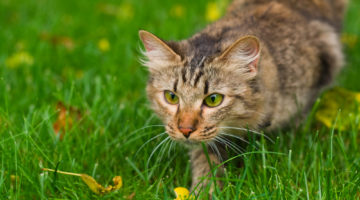What you feed your feline friend can make or break her health. A natural, nutritious diet is the cornerstone of wellness and longevity.
A friend recently lost one of her beloved cats to kidney failure. He was only seven, far too young for him to die. When I asked what she’d been feeding him, my friend revealed that all her cats ate a cheap grocery store brand of commercial dry food. They never got anything else, “because dry food is easier, and if I give them anything different they get diarrhea.” Sadly, I wasn’t surprised that Quince had succumbed at such an early age, and urged my friend to consider switching her remaining cats to a healthier diet.
You’ve probably heard it a million times before, but “we are what we eat”. And it’s as true for our cats as it is for us. Most of the commercial packaged dry and canned cat foods that line grocery store shelves are made from inferior ingredients that do little to support good health, and can even contribute to problems such as diabetes, kidney disease, dental and digestive issues, skin allergies and obesity.
Cats are obligate carnivores, which means they must have good quality meat in order to thrive. Yet most low-end cat foods lack premium protein and are high in weight-inducing carbohydrates such as corn, wheat and other grains. What meats they do contain often come in the form of unnamed meals and by-products, which can include portions of diseased or dying animals. Commercial foods are also full of additives such as artificial colorings and preservatives that can trigger allergies and other health problems. So while these foods may smell and look tasty, and your cat may even enjoy them, they don’t offer much in the way of good nutrition.
Freshen up her menu
The good news is that you don’t have to give your cat these inferior foods. An increasing number of companies are offering wholesome, natural cat foods especially formulated to improve and maintain feline health. These diets contain fresh, high quality ingredients such as whole named meats, fresh vegetables and fruit, herbs and natural preservatives.
A lot of cats will get diarrhea if their food is switched too abruptly, especially if they’ve been eating the same thing for years. To avoid digestive upset, introduce the new food slowly and gradually. Consult a holistic or integrative veterinarian for assistance.
By switching to a premium cat food, you can also choose from a greater variety of food types, including not only canned and high quality kibble, but also frozen raw and freeze dried foods. Keep the following points in mind when shopping for a product:
- Learn to read labels. Good quality foods list whole meats, such as turkey, chicken or lamb. Avoid products that use generic terms such as “poultry by-products” or “fish meal”.
- Meats should come first on the ingredients list, with any grains taking more of a back seat. Keep in mind, though, that ingredients are listed by weight; if the next three ingredients are grains similar in weight to the meat, you’ll end up with a food that’s 75% grains and only 25% meat.
- Don’t rely on the word “natural” as a yardstick of quality. As defined by AAFCO, “natural” indicates that the food or ingredient is in an unprocessed state or doesn’t include chemical additives — but it doesn’t address the quality of the ingredients. This means by-products and other cheap ingredients may still be used.
- Steer clear of foods containing the synthetic preservatives BHA, BHT and ethoxyquin. Look for natural alternatives such as vitamins C and E, rosemary and mixed tocopherals.
- All canned and dry foods have added vitamins and minerals, but they need to come in a form that can be absorbed by the cat. Ester C and chelated minerals are two good examples.
- Wherever possible, look for products that include certified organic ingredients. The key word here is “certified”.
- Because cats were originally desert dwellers, they tend not to drink as much water as dogs do. If your cat eats a dry diet, make sure it’s a premium, meat-based product, and not one that’s mostly all grains. Some manufacturers of high quality dry foods coat their kibbles with a layer of freeze-dried raw meat for an extra nutritional punch. If the food contains any grain, it should be whole; avoid products that include white flour, rice husks, soybean meal or gluten. Supplement a dry diet with some wet food.
- A lot of people balk at feeding raw food, but today’s frozen raw diets make it really easy, hygienic and convenient. Raw meat on its own doesn’t constitute a complete and balanced diet, but manufacturers add all the necessary nutrients and form the food into handy tubes, medallions or nuggets that are easy to thaw and serve.
- Think variety when feeding your cat. Don’t just feed her one flavor all the time. Rotate brands and protein sources – many premium pet food companies offer not only chicken, turkey, beef, salmon or lamb, but also tasty alternatives such as bison, rabbit or venison. Giving your cat a premium diet will cost more, but it’s worth it. By feeding her a healthy diet today, you’ll save on vet bills tomorrow – and you’ll enjoy her love and companionship a lot longer!







2018 Video recommended Rad CaT Raw(no longer available) What’s recommended now?
Many companies that sell raw dog food also market their recipes to cats! Most of them are great for felines, but it’s important to talk to your vet (or an animal nutritionist) to ensure whatever diet you’re feeding your pet is meeting her nutritional needs. Blood tests can be extremely helpful! Chances are, you’ll have to give your cat a few supplements in addition to her daily raw meals.